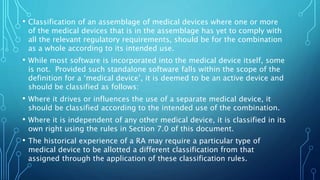The document outlines the role and purpose of the Global Harmonization Task Force (GHTF) in promoting convergence of medical device regulatory practices across member jurisdictions. It details the establishment of five study groups, including one focused on pre-market evaluation, and specifies a classification system for medical devices based on their potential risks, along with definitions and manufacturing guidelines. Additionally, it discusses regulatory controls associated with different classes of medical devices to ensure safety and effectiveness while supporting global trade and technological innovation.


















































![expected to have the basic elements of a QMS in place but need not include design and
development activities.
The QMS for manufacturers of Class A devices is normally not subject to premarket on-site
audit by the RA or CABSystem for post market surveillance
Prior to placing the product on the market, the manufacturer will put in place, as part of its quality management system, a process to
assess the continued conformity of the device to the Essential Principles of Safety and Performance throughout the IVD medical device
lifecycle. This process will include, at a minimum, complaint handling, vigilance reporting, and corrective and preventive action[1].
The RA or CAB may confirm that such a process is in place, usually at the time of the quality management system audit[2].
Technical documentation
1.The technical documentation provides the evidence that the IVD medical device meets the Essential Principles.
For the purposes of conformity assessment, the manufacturer will establish a subset of technical documentation (Summary Technical
Documentation (STED)) to be submitted, as required by the class of the device. A description of that subset will be provided in the GHTF
guidance document: Summary Technical Documentation for Demonstrating Conformity to the Essential Principles of Safety and Performance of
IVD Medical Devices (STED). The extent of evidence in that STED is likely to increase with the class of the IVD medical device and its
complexity.
The RA or CAB determines the adequacy of the documented evidence in support of the manufacturer’s Declaration of Conformity to the
Essential Principles through a review of the STED. The depth and the timing of the review is likely to be influenced by the risk class of the IVD
medical device and its complexity.](https://image.slidesharecdn.com/ghtfstudygroup1richatrivedi10-200918052135/85/GHTF-Group-1-51-320.jpg)















